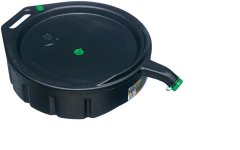Apologies to all. Barry pointed out that I hadn't posted the oil change routine, or if I did, neither of us could find it.
Here is how I changed the oil in the tank on my 1445.
Things on hand before starting;
- 25 gallons of Mobil1 (I used 5W50) synthetic oil. (I got it at Walmart, on sale)
- 25 one gallon milk jugs for the used oil (Around here, the preferred size for recycling.)
- One semi rigid dishwasher drain hose, complete with rubber adapter to fit over the drain plug (Lying around, or HD/Lowes)
- Three 8x8" x 2'
- An engine oil pan for changing oil to catch the drips
- Optional: Some hose clamps to clamp the bits of hose together
- Optional: a spring clamp to hold the end of the hose above the tank to keep from spilling oil. (You can clamp it to the seat.)
- Optional: One drill type mini pump
- Optional: if you use the pump, 3' of old garden hose to go from the pump to the milk jugs
First: Put the brakes on! Chock the right side wheels, just in case.
Getting the PT angled:
I put the PT up on 8"x8" blocks on the left side (my drain plug is on the right). I did this by using the FEL to lift the front, and then putting two blocks under the left side of the oil tank, ahead of the rear tire, by lowering the FEL. Raised the FEL. I then had clearance to put one 8x8 under the rear tire. Lowered the FEL and put an 8x8 under the front tire. Time taken, about 1 min. The PT now has an 8" list to starboard, and it helps drain the oil. If you have a nice kerb or berm near where you want to drain it, that would work, too.
Draining:
I wear nitrile gloves, just in case. I then connected the pump to the hoses. I put the engine drain pan under the drain plug, and used a pair of vice grips on an allen wrench to get the plug out. As soon as it was free, I popped the rubber end of dishwasher hose on and put a worm drive hose clamp on it. I spilled a couple of tablespoons of oil. I used a mini pump for the rest, and I then pumped the oil out a gallon at a time.
Having the PT at an angle really made the draining easy and nearly complete. In the end, all but a couple of ounces drained out of the tank. Since the bottom was sludge free in my case, I decided not to add anything else in to try and clean the bottom. If you did, you could use the mini pump to spray your cleaning solution around in the tank and recirculate it to suspend the sludge.
Don't for get to change the oil filter while the tank is draining, as another slug of oil will drain back in to the tank when you break the seal on the oil filter.
Filling:
I added a small neodymium magnet to the drain plug (can't hurt department) and wrapped on some Teflon tape and put it in. Added oil until it was full, did the charge pump bypass routine to bleed the suction line of air. That took longer than normal, because of the empty suction hose.
The only difficult bit was finding a place to take all of the oil. Most recycling places around here only take 3-5 gallons at a time. I did notice that after ~7 years of use, my 10W40 was noticeably less viscous than new 10W40.
I hope that this helps.
All the best,
Peter
P.S. Several years into the 5W50, I can't say that I notice much of a difference from 10W40, other than being slightly stiffer steering when cold.
